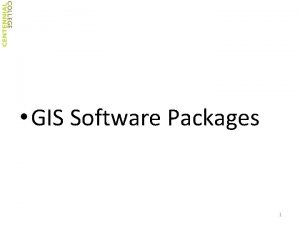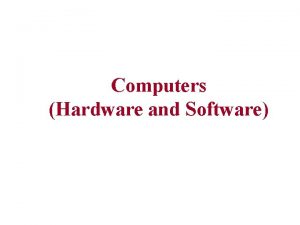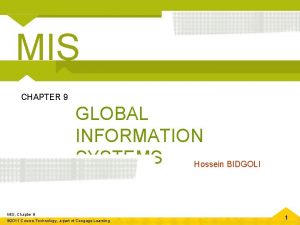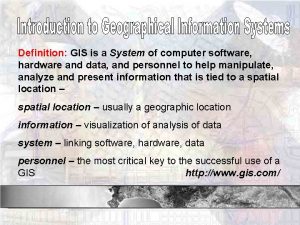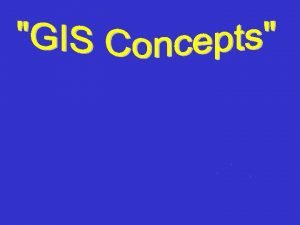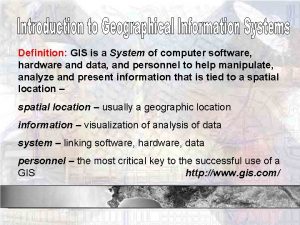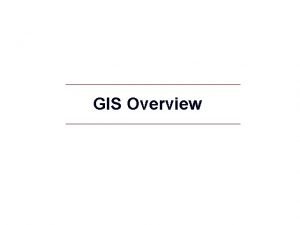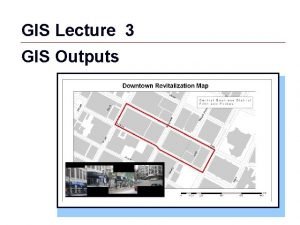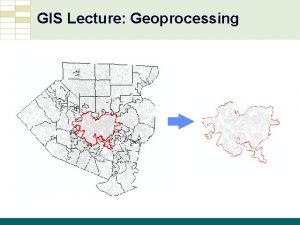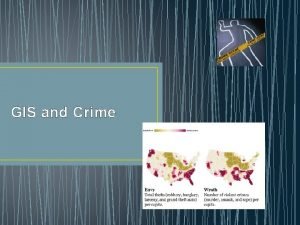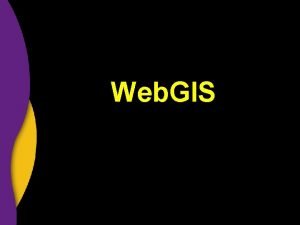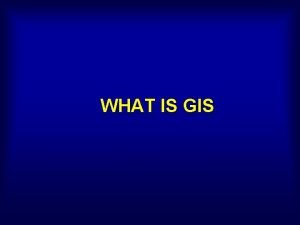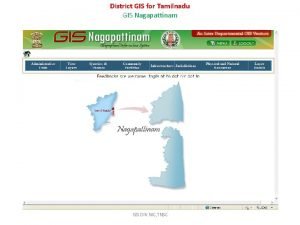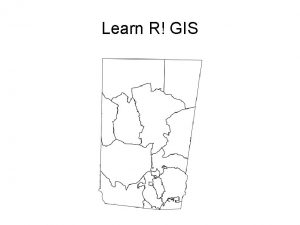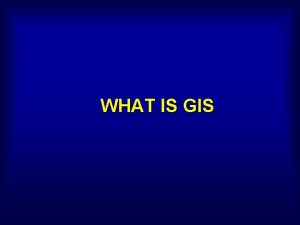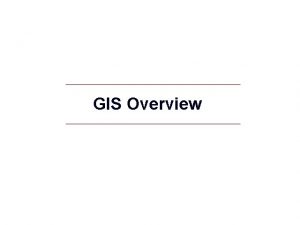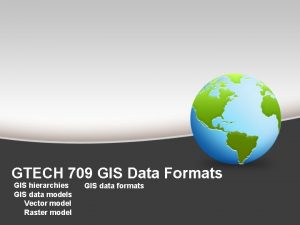Definition GIS is a System of computer software















- Slides: 15

Definition: GIS is a System of computer software, hardware and data, and personnel to help manipulate, analyze and present information that is tied to a spatial location – usually a geographic location information – visualization of analysis of data system – linking software, hardware, data personnel – the most critical key to the successful use of a GIS http: //www. gis. com/

Types of data that can be included in a GIS • Cadastral information • Images • Land Uses • Inventory of Natural Resources • Market Analysis and Trends • Planning Schemes • Risk Analyses • Analytical Models and Simulations In summary if the information has any spatial component it can be presented within a GIS.

History of GIS • 1960 s – Restricted to paper-based systems “Maps” • 1970 s – First Digital Mapping • Early 1980 s – first Computer Aided Design or CAD packages • Mid 1980 s – First GIS using Workstations • Late 1980 s – Desktop Mapping, Integration of CAD with Databases, birth of PC-based systems • Early 1990 s – Desktop GIS with full integration of data • Mid 1990 s – GIS became more accessible with Windows based destop GIS • Late 1990 s – GIS became functional over the Internet • Early 2000 s – full integration of GIS into applications e. g. In Vehicle Navigation Systems

How does GIS vary from other Graphics Programs ? • Computer-aid design (CAD), computer cartography, database management and remote-sensing were all important in the development of GIS, however, • a GIS allows information to be linked to an object, such as point, line or polygons. Consequently information can be calculated from the topography of the object or information can be attached to the object and stored in a separate table. • a GIS has the ability to shade various land parcels (districts) according to ranges of specified variables. This makes identification of spatial relations within the data set easy to identify.

DIFFERENCE BETWEEN A GIS AND MAPS/ATLASES • Maps have to be printed and in relatively large formats • Although maps can be compiled into an Atlas, they are not seamless and you have to compare one page with another • Maps have to be printed at fixed scales • Maps cannot provide all the annotation you might require with respect to shading and place names • Although Maps should always include a scale bar it is still not easy to calculate the lengths of features represented on the map and is almost impossible to determine areas with any reasonable accuracy.

GIS Maps are Customizable • With a GIS you can combine information that you wish to use and ignore information that is redundant to your needs • Each feature of a Map is stored in a GIS as a series of files that collectively are referred to as a “layer” or “coverage”. You can add different coverages onto each other • A GIS allows the different representation and colour of points, the colour and style of lines, the colour and shading properties of polygons, the colour, font, size and orientation of labels to be changed • One of the most important aspects of a GIS is the displaying of information attached to the coverage which can also be represent by colour gradients or by unique colours according to attributes with a linked table of information

GIS Maps are Searchable • Any of the data whether it be within the associated table or be a measurement of the object and whether it’s numerical or text can be searched and identified. • Searches can be simple such as find all estuaries which are always open to compound searches such as find all estuaries that are always open and have a mangrove population. • Searches can be based on features based on the parameters of map features - e. g. the length of sandy beaches along a coastline that are longer than 5 km

GIS Maps are Updatable • Since the information is stored electronically information is easily updated without require republishing. • This information ca be writen to CD and can dispatched to offices or made available via a network • More recently advance in GIS applications allow information to be updated and available to the entire users of the World Wide Web. • Consequently information can be maintained in its most current form and optimizes decision-making.

What Computers Would You Need To Run A Gis? • A typical GIS is fairly complex and the databases and images are usually large - they consequently take up considerable disk space. • Needing to handle so much data requires a fasir amount of memory and processing power. • Backups of data can be undertaken using tapes or rewritable CDs • Often GIS software is graded into being able to view data, to minor alterations, to full customizing and programming (usually BASIC) and finally through to a full centrally managing large or “corporate” application.

Where Can You Get Data? • Purchase data from government and commercial vendors. • Data supplied via internet services, or via online viewing and downloading of files, e. g. Western Cape Nature Conservation Board is starting this. • Meta databases – which can be maps which provide information on suppliers of spatial information. • With high bandwidths you can even log into different servers and mix data from different sources, and first system now exists where you can upload your data to a map service for distribution via the world-wide web.

Who Produces Digital Maps? • North America - USGS provide togographical maps, satellite imagery, correct orthophotos, scanned copies of paper maps, etc. • South Africa – Chief Directorate Surveys and Mapping provide the above products • Increasingly in South Africa, private companies are providing more of the data. Consequently Computamaps in Cape Town has developed and markets very high resolution (20 m) Digital Terrain Model for South. Africa that are extensively used in the mobile telecommunications industry. The Knowledge Factor has map of all land parcels in South Africa and records of ownership as reflected in the Deeds Office.

Obtaining New Data • The USGS develops from aerial photography, digital, geocorrected orthophotographs of pan imagery at 1 metre resolution for the entire country every 5 years. • In South Africa many parts have never had any orthophotographs prepared. The most accurate digital elevation model which records height data was for a resolution of 200 metre raster grid cells from the Surveyor General for South Africa. • More Accurate Digital Terrain Information can be acquired using the LIDAR (look this up) and Digital Elevation Models with centimeter resolution for small areas are being prepared. • Virtually all new maps being prepared nowadays are done through a GIS and hand drawing is very much a thing of the past.

Types Of GIS • There are two types of GIS which store the information in very different format. These are known as vector-based and raster-based. • Originally there was little cross functionality between the two systems, however, most current software has the ability to present both systems • Some software such as TNT Mips has extensive functionality in both systems.

Raster: Grids uses “pixels” for location and value attributes and includes satellite-images and digital aerial photos are already in this format. Each grid will have a value that corresponds to some feature, for example water might have a value of 6 and there fore all grids which have a value of 6 represents water. Raster-based GIS systems are not strong on the data-base functionality, but are good for modeling.

Vector – Linear: Points, Lines & Polygons Vector GIS use points, lines and polygons to represent features. Since such features are precisely define by geographical co-ordinates, they are useful for accurate calculation of measurements and are easily attached to tabulated data for querying. Vector-based GIS are used extensively for management such as municipal offices would require
 Gis computer science
Gis computer science Gis computer science
Gis computer science Gis software packages
Gis software packages Define components of computer
Define components of computer What is computer organization
What is computer organization What is system design in software engineering
What is system design in software engineering A computer system consists of both hardware and software
A computer system consists of both hardware and software In a global information system (gis), high coordination:
In a global information system (gis), high coordination: Application software and system software difference
Application software and system software difference Is an os system software or application software
Is an os system software or application software Hardware computer definition
Hardware computer definition Definition of gis
Definition of gis Gis hardware components
Gis hardware components Gis definition
Gis definition Gis definition ap human geography
Gis definition ap human geography Choropleth map example ap human geography
Choropleth map example ap human geography


